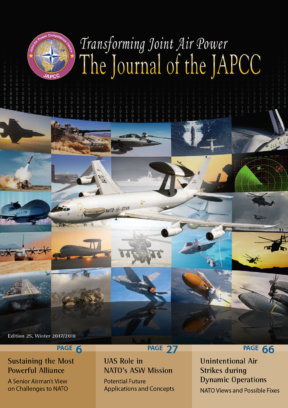Introduction
Since NATO’s inception, airpower’s role has evolved from a key enabler of military capability to that of a primary means of executing the Alliance’s three core tasks: collective defence, crisis management and cooperative security. With today’s fluid political landscape and rapid technological advancement, NATO has begun to anticipate future security environments in which it may have to operate, including a contested, degraded, and operationally limited (CDO) environment. NATO’s military forces must be prepared to match not only rapid developments in technology but also an adversary with the political will and capacity to employ these capabilities to decisively alter the geopolitical landscape. The JAPCC’s 2016 conference brought focus to this narrative, concluding that after nearly two decades of uncontested air operations, today’s environment is in fact CDO. The conference further provided clarity, defining the contested as ‘things the adversary does to directly hamper the mission’ (e.g. electronic warfare, cyber attacks); the degraded environment as ‘things that happen in the natural course of events’ (e.g. stuff breaks); and the operationally limited as ’caused by the physical or operational environment’ (e.g. capacity-limited Link 16 network).1 It was also agreed that the particular challenges for the CDO environment of the foreseeable future are instantaneous effects from increasing multidimensional threats.
Given these challenges, NATO must learn how to employ its joint capabilities as a cohesive multi-domain force. This will allow for dynamic action across the domains to provide precision engagement with the desired amount of force, at the desired time, regardless of the battlefield conditions. These synergistic effects cannot be accomplished using the traditional approach of separate components coordinating in traditional supported-supporting relationships, where each component still subordinates Joint Force objectives to priorities in its own domain that constrain the capabilities provided to the Joint Force Commander (JFC). For success in future warfare, JFCs must have real-time situational awareness of all assets in the battlespace and the ability to communicate and re-direct forces as the environment dictates. A critical component in providing NATO with this strategic advantage is its airborne Battle Management Command and Control (BMC2) capability, specifically the NATO E-3A Airborne Warning and Control System (AWACS). Current efforts to modernize the AWACS will provide Multi-Domain Command and Control (MDC2) capability required to meet challenges of future operational environments.
From Joint to Multi-domain Operations
Over the last quarter century, operational airpower has been a key and critical component to maintain the Alliance’s strategic advantage. Operational concepts such as ‘Air-Land’ and ‘Air-Sea’ Battle were pivotal evolutions in defining how airpower can deliver cross-domain synergy.2 However, in 2011, then Chairman of the United States Joint Chiefs of Staff General Martin Dempsey asked ‘What’s after joint?’3 The answer is multi-domain. Multi-domain operations are the ‘exploitation of asymmetric advantages across multiple domains (air, land, sea, sub-surface, space and cyberspace) to achieve freedom of action required by the mission.’4 Quite possibly the most unique challenge to achieving this is understanding MDC2.
MDC2 can be defined as C2 across all domains that protects, permits and enhances the conduct of operations to create desired effects at the time, place and method of choosing.5 Recently, the Chief of Staff of the US Air Force published a white paper that describes three characteristics of MDC2: situational awareness, rapid decision-making, and the ability to direct joint forces to achieve Commander’s intent.6 The challenges with operationalizing this concept reside in three domains: technical, policy, and human. In the technical domain, MDC2 systems must have a network that supports the exchange of ‘big data’, removes stove-piped data streams, and improves interoperability. Further, we must be able to identify and remove policy barriers to interoperability to shorten the time from data to decision. Last, in the human domain, command authorities must be established and easily delegated to the tactical level so that those with tactical control (TACON) can produce effects across domains, in real-time. This authority, when distributed to the right level, will link the Commander’s Intent to tactical action, employing the right amount of force, at the right time, in the right place and with the right method of choice for maximum effectiveness.
To this end, NATO continues to transform its military force structure in separate air, land and maritime components. To ensure effective MDC2, however, a platform must be selected which can readily observe and communicate across the space, air, ground and surface domains. As NATO’s key airborne tactical BMC2 asset, the E-3As are the logical platform for future MDC2 operations. They are uniquely qualified to engage in multi-domain operations, as they already engage in air, ground and surface BMC2. The next evolution of the E-3A will expand its capabilities in the space domain and enhance many of its existing air, ground and surface abilities, to provide the technical capability for effective MDC2 in NATO 2025 and beyond.
Evolution of the E-3A: Mission and Modernization
Four major modifications to the E-3A fleet in the past 25 years prove the platform can respond to military challenges or changing political environments.
Near-Term Modification Program. The first modification, known as the Near-Term Modernization Program, was conducted in the early 1990s, while the world was still adjusting to the collapse of the Soviet Union. It significantly enhanced the radar capabilities allowing detection of smaller and slower targets at the expanded range, and it added electronic surveillance measures for improved passive detection of static and mobile emitters. To effectively communicate with maritime elements, the E-3A’s communications capabilities were also upgraded to include anti-jam UHF radios and Link-16.
NATO Mid-Term Program. During NATO’s involvement in Bosnia and Kosovo in the 1990s, the E-3A’s role was expanded from a simple Airborne Early Warning platform to that of a flying Command and Control (C2) entity. This second round of modifications, known as the NATO Mid-Term Program, was approved in 1997. The C2 enhancements included the addition of new situational display consoles to allow for additional mission crew in-flight, multi-sensor integration for improved target identification and tracking, the addition of full-spectrum VHF radios for communications with a wider range of aircraft and ground forces, and an improved internal communications network and satellite communications system for long-range voice and data transmission.
Large Aircraft Infrared Counter Measures. The third modification of the E-3As began for the 2001 deployments to Afghanistan in support of the International Security Assistance Force (ISAF). The mission required a Large Aircraft Infrared Counter Measures (LAIRCM) system to operate from within the theatre of operation. LAIRCM is an automated system designed to protect aircraft during take-off and landing when they are vulnerable to MANPADS and other portable infrared guided missiles. Following the addition of LAIRCM, NATO E-3As were able to support ISAF from bases within Afghanistan itself, not only increasing on-station availability while substantially reducing fuel requirements, but also allowed Commander’s to accept greater risk with a traditionally low-risk platform.
Follow-on Upgrade Program. To keep pace with the civil aviation requirements in NATO countries, the fourth modification, known as the Follow-on Upgrade Program, was implemented in 2010. This upgrade included a Next Generation IFF (Mode 5) and enhanced Mode S capability for improved identification capability and replacement of the analogue flight instrumentation with the new Communication, Navigation and Surveillance/Air Traffic Management (CNS/ATM) ‘Glass Cockpit’ system to ensure access to global airspace.
These modernization efforts helped the E-3As to adapt and perform missions beyond those for which they were originally designed. In the aftermath of the drawdown from operations in Afghanistan, NATO shifted its strategic direction and reaffirmed the need to modernize the E-3As to remain ‘operationally relevant through 2035’. To extend the E-3As’ operational life for another ten years, the NAEW&C Force with the support of SHAPE identified key capability gaps to advance and modernize the fleet to meet the strategic directive.
Final Lifetime Extension Programme
Since 2014, the NATO Airborne Early Warning and Control Force Program Management Agency (NAPMA) managed development of the Final Lifetime Extension Program (FLEP) to fill those capability gaps. The engineering, manufacturing, and development phase is scheduled to commence in 2019, where NAPMA will work with US and European contractors to provide a modernized, networked, secured, multi-domain capable Battle Management and Command & Control platform to serve until a replacement is fielded. FLEP will address six major areas to improve the E-3A’s MDC2 capabilities. These areas include:
Tactical Data Links (TDL). The FLEP will replace the existing terminal with a modern, crypto-compliant terminal capable of Concurrent Multi-netting and add IP-based, beyond line-of-sight capability with Joint Range Extension Applications Protocol C encapsulation.7 This capability will not only aid in alleviating the capacity constraints of current Tactical Digital Information Link networks, but will also allow for the adaptation of future waveforms for greater and more secure information exchange, communication and enhanced situational awareness. Alleviating the capacity constraints of today’s data network environment is a pre-requisite to the amount of data that can be collected by 5th generation sensors and platforms.
Secure Communications. To meet external mandates, the voice, data, and TDL cryptographic units will be replaced with modernized units to ensure secure communications and interoperability with NATO partners.
Airborne Networking. The wide-band SATCOM antenna installed under the CNS/ATM project will be modified to increase data streaming capability to 2 Mbps, a massive increase over today’s capability. This will support the integration of advanced information sharing capabilities and handle the ‘big data’ (e.g. off-board sensor data) required to support operations beyond 2025.
Anti-Jam Communications. Current VHF and UHF radios will be replaced with modern, securable, anti-jam capable radios to establish and maintain communications with air, ground and surface forces in contested electromagnetic environments.
Passive Detection. The Electronic Surveillance Measure system will receive a much needed upgrade in processing capability to allow for faster emitter identification and reduction of unknown emitters. The ability to provide more timely and accurate identification of potential threats will allow the E-3A to bring order to chaos in the fight of the future.
Mission System. Due to the number of improvements added under FLEP and the advancements in computer technology since the last upgrade, the Mission Computing system will receive new hardware and a significant change in software architecture. The new features and capabilities will alleviate capacity and processing constraints of existing computer technology that is ill-equipped to handle the massive amounts of data provided by organic and inorganic sensors.
Most notably E-3As will continue to provide accurate and timely identification of air and surface targets and will gain the ability to detect, track, and identify ground targets and emitters through the ability to process off-board, ground moving target indications (GMTI). The ability to detect, track, and identify enemy movement in the air, land, and surface domain and communicate these threats beyond line-of-sight will support enhanced situational awareness and enable rapid decision making at the tactical and operational levels, allowing forces to achieve Commander’s intent. Moreover, the enhanced airborne networking capability provides the necessary bandwidth to process ‘big data’ to ensure timely and decisive action.
For these technologies to be effective in 2025 and beyond, we must also examine the barriers in policy that prevent the rapid and free-flowing exchange of data between sensors, systems, platforms, networks, and people. While the commitment of national resources to the Alliance continues to be a source of strength, we must also consider the barriers invoked by policy that can diminish interoperability and our strategic advantage. MDC2 within NATO will require strategic alignment of people, plans, resources, requirements and technologies in order to preserve a competitive advantage. From a systems perspective, MDC2 is neither capabilities-based nor effects-based; it instead relies on resilience, interoperability and authority. Systems must be resilient in order to be effective in a multi-domain environment; they must also be able to communicate with each other and appropriate command. Last, while traditional air power capabilities have been measured by speed and reach, MDC2 systems will be measured by their ability to achieve Commander’s intent, its level of adaptiveness and finally its survivability. The only way this last part is achieved is through the systematic integration of people, ideas, weapons and platforms so MDC2 systems can adapt these variables to the situation as we can never wargame the perfect storm. We must therefore also seek to find those emerging enablers vs technological game-changers in order to achieve operational agility.
Conclusion
The imperative for effective MDC2 is clear. The ability to harness capabilities across multiple domains and more importantly, provide effective command and control across domains produces dilemmas for our adversaries at a pace they will never match. Airborne C2 nodes such as the E-3A will continue to be critical in gapping the tyranny of distance in a boundary-less, multi-domain environment. The ability to overcome fog, friction and chance through on-scene or localized situational awareness remains the E-3A’s most competitive advantage in 2025 and beyond. MDC2 systems, like a rapidly-deployable and FLEP-modernized E-3A, will provide operational commanders with an action arm in the battlespace to achieve desired effects. Moreover, it will require the strategic alignment of people, plans, resources, requirements and technologies in order for NATO airpower to preserve its competitive advantage in 2025 and beyond.













